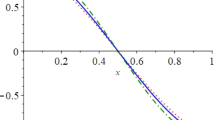Abstract
Based on the convergence rate defined by the Pearson-X2 distance, this paper discusses properties of different Gibbs sampling schemes. Under a set of regularity conditions, it is proved in this paper that the rate of convergence on systematic scan Gibbs samplers is the norm of a forward operator. We also discuss that the collapsed Gibbs sampler has a faster convergence rate than the systematic scan Gibbs sampler as proposed by Liu et al. Based on the definition of convergence rate of the Pearson-X 2 distance, this paper proved this result quantitatively. According to Theorem 2, we also proved that the convergence rate defined with the spectral radius of matrix by Robert and Shau is equivalent to the corresponding radius of the forward operator.
Similar content being viewed by others
References
Tanner, M. A., Tools for Statistical Inference: Observed Data and Data Augmentation Methods, Lecture Notes in Statistics, 67, Berlin: Springer-Verlag, 1991.
Geman, S., Geman, D., Stochastic relaxation, Gibbs distributions and the Bayesian restoration of images, IEEE Tran. Patten Anal. Mach. Intell, 1984, 6: 721–741.
Schervish, M. J., Carlin, B. P., On the convergence of successive substitution sampling, J. Comput. Graph. Statist., 1992, 1: 111–127.
Liu, S. J., Wong, W. H., Kong, A., Correlation structure and convergence rate of the Gibbs sampler with various scans, J. R. Statist. Soc. B, 1995, 57: 157–169.
Liu, S. J., The collapsed Gibbs sampler in Bayesian computation with applications to gene regulation problem, J. Amer. Statist. Assoc., 1994, 89: 958–965.
Liu, S. J., Wong, W. H., Kong, A., Covariance structure of Gibbs sampler with application to the comparisons of estimators and augmentation schemes, Biometrika, 1994, 81: 27–40.
Robert, G. O., Shau, S. K., Updating schemes, correlation structure, blocking and parameterization for the Gibbs sampler, J. R. Statist. Soc. B, 1997, 59: 291–317.
Geng, Z., Wan, K., Tao, F., Mixed graphical models with missing data and the partial imputation algorithm, Scand. J. Statist., 2000, 27: 433–444.
Amit, Y., On the rate of convergence of stochastic relaxation for Gaussian and non-gaussian distribution, J. Multivar. Analy., 1991, 38: 82–99.
Yosida, K., Functional Anaylsis, 6th ed., New York: Springer, 1980.
Dep. Math., Nanjing University, Functional Anaylsis (in Chinese), Beijing: People’s Education Press, 1961.
Author information
Authors and Affiliations
Corresponding author
Rights and permissions
About this article
Cite this article
Li, K., Geng, Z. Convergence rate of gibbs sampler and its application. Sci. China Ser. A-Math. 48, 1430–1439 (2005). https://doi.org/10.1360/02ys0013
Received:
Revised:
Issue Date:
DOI: https://doi.org/10.1360/02ys0013




